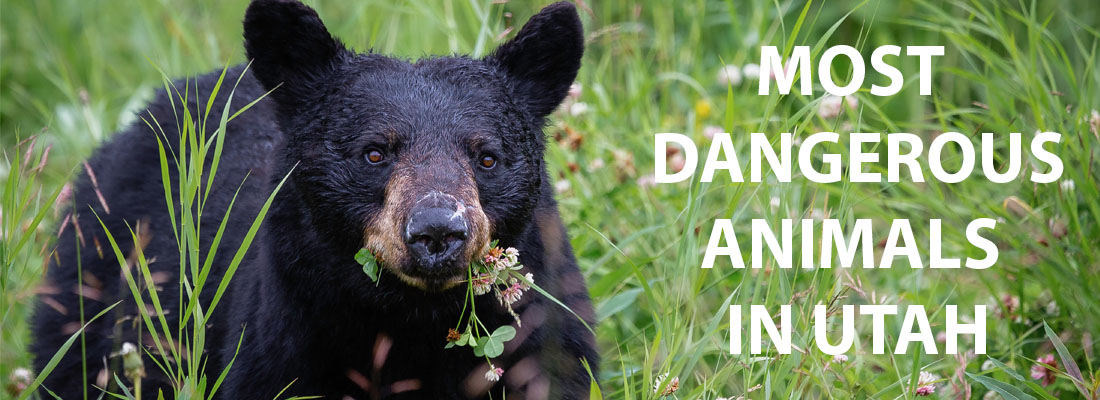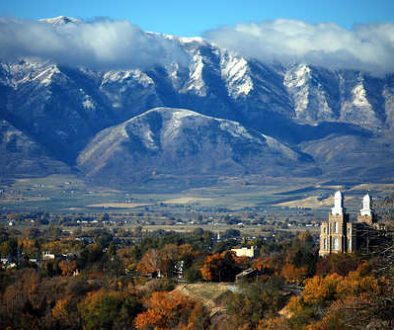The Most Dangerous Animals in Utah

Utah is a beautiful state with diverse landscapes and climates. However, along with the unique beauty of the state, there are a variety of dangerous animals in Utah. From mountains perfect for hiking and camping to the majestic national parks near the southern portion of the state, there is endless territory to explore. While it’s tempting to snap a close-up pic of the many animals and reptiles found throughout the state, proceed with caution. If you plan on exploring the great outdoors of Utah, knowing the wild creatures you’re likely to encounter is a great place to start.
Dangerous Wildlife in Utah
Utah is the thirteenth largest state in the country, covering 84, 914 square miles. The state comprises three major geographic regions: the Rocky Mountains, the Basin and Ridge Region, and the Colorado Plateau. These areas include animals such as the Rocky Mountain elk, Desert bighorn sheep, coyotes, and mountain lions just to name a few.
Some of the wildlife causing the most injuries and deaths in the state of Utah may very much surprise you. It isn’t always the lions, tigers, and bears that you need to be afraid of.
Poisonous Animals in Utah
When you think about what animals in Utah are poisonous, you would probably expect a fairly short list. However, taking into consideration the various snakes, lizards, spiders, and insects that have poisonous venom, the list is a hefty one. Scorpions, rattlesnakes, brown recluse spiders, blister beetles, and the hobo spider are just a few of the poisonous creatures found in the Beehive state.
10 Most Dangerous Animals in Utah
We’ve compiled a list of the top 10 most dangerous animals you might encounter in Utah. Starting with the most dangerous and working the way down, these animals are the ones to be cautious of:
-
American Black Bear
You may be surprised to hear that there are over 4000 black bears living in the state of Utah. While these large predators won’t attack humans as food, they will charge the moment they feel threatened, especially if their cubs are involved. Bear attacks in Utah are rare but when they do happen, they cause severe injury and even death.
There can be quite a bit of confusion around what to do if you do encounter a black bear. We used to believe that playing dead or curling into the fetal position was the safest way to defend oneself. However, the best thing is to stand your ground. Don’t back away or lie down. Remain calm and see if the bear chooses to ignore your presence and move on.
Never run away or climb a tree because chances are the bear is a better climber and faster runner than you are. Always hike and camp with bear spray that is easily accessible.
-
Moose
Moose can seem harmless due to their wide bodies and large antlers, not to mention the way they are portrayed in cartoon form. But this couldn’t be further from the truth. They appear grand and serene when spotted in the
wild but should never be approached. Moose are extremely aggressive and move much faster than you might think. Too many people assume they are friendly and either want to get a closer look or try to pet them like a horse. If you happen to encounter a moose in the wild, keep your distance and look for signs of aggression. This would include lowering their head as if to charge, licking their snout, and noticing if their ears are pinned back. Moose attacks result in being stomped or sat on and being gored by their antlers. It never ends pretty. It’s also important to note that Moose are aggravated by dogs. So leave your furry friends at home when in Utah moose territory.
-
Rattlesnake
If you live in Utah, you know the dreaded sound of a rattle and a hiss along a hiking trail. Even though rattlesnakes try to remain illusive when it comes to humans, once you enter their habitat, all bets are off. They thrive in the dry, arid Utah climate and in seasons of drought are drawn to more residential areas to find water.
While rattlesnake bites are rare, it’s smart to know how to react if you come upon one in the wild. A snake will strike when it feels cornered or threatened. Keep your distance and give it its space. Poking or throwing things at it will provoke it and things might not end well. The venom rattlesnakes produce can cause long-term damage to your brain and nervous system. If you’re bitten, seek medical attention as quickly as possible.
-
Mountain Lion
Mountain lion sightings in Utah are rare. Lucky for us, they do their best to avoid humans. Still, when they feel we are a threat in any way, they can pose quite a threat. If you come upon a cougar in the wild, the best thing you can do is make yourself appear as large and intimidating as possible. This involves speaking in a firm and loud tone and raising your arms above your head. Do not run away. This triggers their instinctive response to prey and may cause them to chase and attack.
-
Black Widow Spider
There are few spiders that strike fear in humans as intensely as the black widow. Typically arachnids don’t become bothersome by entering your home until fall. However, they can still pose a threat during the summer months if encountered doing yardwork or during outdoor recreation. Children and the elderly are particularly susceptible to this spider’s venom. At least the black widow is fairly easy to recognize by the distinctive red hourglass marking on the bottom side of their abdomen and shiny black appearance. Only adult female widow spiders pose a threat. Males have smaller venom glands and fangs, making it more difficult to penetrate human skin. If you suspect you’ve been bitten, call the Utah Poison Control Center or see a doctor.
-
Gila Monster
The Gila monster is a venomous lizard native to Southern Utah, Nevada, New Mexico, and parts of California. It’s the only venomous lizard native to the United States. This lizard is easily recognized by its black and yellow or black and pink beaded skin pattern and is generally around 2 feet long. Because they spend 95% of their time underground or burrowing under rocks, spotting a Gila monster is a rare experience. They are most active during morning hours in the spring or towards the beginning of summer. While they are sluggish and not usually aggressive, you should avoid handling them. They have quick reflexes and can attack very suddenly. A Gila monster’s venom is extremely toxic, similar to that of a rattlesnake. If bitten, seek medical attention immediately.
-
Coyote
Coyotes can be found throughout the United States and are quite commonly found in Utah. They adapt to a wide range of habitats, including suburban neighborhoods, urban cities, deserts, grasslands, and forests. They feed on small mammals, reptiles, birds, grasses, and fruit. Coyotes are seldomly a danger to humans but tend to seek out your trash and pet food supply. They may also think your pet is food.
To deter coyotes, fence your yard and supply a secure shelter for your pets or farm animals. Actively discourage coyotes from your property by installing strobe lights and sirens to scare them away. And keep in mind that if you encounter a coyote in the wild, make as much noise as possible, never approach them directly, stomp your feet, and throw rocks or sticks at them if necessary to scare them away.
-
Mosquito
The mosquito is certainly the most common creature on this list. Obviously, the thing that makes mosquitoes so dangerous is the variety of diseases they carry and transmit. Among the most serious are the West Nile Virus and two forms of encephalitis. Lucky for you, mosquitoes may be swarming in Utah in the summer but once the cooler weather rolls in, they aren’t an issue.
-
Raccoons
Raccoons are cute and cuddly and other than getting into your trash and making a mess can’t be dangerous, right? Well, these animals have extremely sharp teeth and claws and can become very aggressive. This is a problem because they carry rabies which can be fatal if you aren’t vaccinated for it. They have also been known to attack adults, children, and pets and inflict significant harm.
If you are approached by a raccoon or happen to encounter one, break eye contact and slowly walk away. If they continue to approach or become aggressive, make yourself appear as large as possible. Waver your arms in the air, stand tall, and yell loudly if necessary.
-
Scorpion
Scorpions may be small but their sting is certainly painful. One scorpion sting can cause excruciating pain, numbness of the body, swelling, and vomiting. Symptoms can last anywhere from 1-3 days. Most scorpions in
Utah are found in the deserts of Southern Utah. They are nocturnal creatures and hide out during the day. If you are bitten by a scorpion, stay
calm, clean the area, use a cold compress on the affected area, then call the Poison Center at 1-800-222-1222.
Who is Liable for Wild Animal Attacks?
When a wild animal attacks, it can leave the person involved with serious injuries. Unlike domestic animal attacks, such as a dog bite, it can be complicated to determine who is liable, if anyone. If a wild animal was under someone’s care at the time of the attack, there may be a possibility of pursuing compensation for injuries or health concerns. There may have been negligence or lack of restraint when dealing with potentially dangerous animals.
The Most Dangerous Animals in Utah Conclusion
If you’ve been injured due to an interaction with a dangerous animal, the attorneys at Harris, Preston, and Chambers can help. They will review your situation and help you know if it’s worth pursuing your case or not. With all the various dangerous creatures living in the state of Utah, it’s certainly a good idea to be aware of the wildlife around you and how to protect yourself. We serve all of Utah including Salt Lake City, Logan, St George, and Ogden. Contact us to get your free consultation.
*Nothing herein constitutes legal advice. You should obtain independent legal counsel regarding your specific factual situation.



